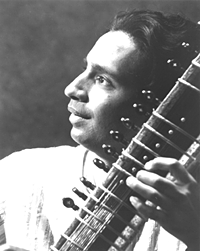


Around the world, music lovers have embraced the creative, spiritual art of Indian music. Audiences from New York to Tokyo are captivated by masters of the sitar, sarod and tabla, three popular Indian instruments. The music's renown is evidently based on its immediate beauty, as well as the ever-deepening layers of meaning that evolve with further listening.
The most famous disseminator of Indian music in America is Ravi Shankar, known for, among other things, his riveting performance at Woodstock and his well-publicized friendship with the Beatles.
Kartik Seshadri, a disciple of Shankar, performs around the world. His music has taken him to such diverse locales as Britain, Israel and the United States. Apart from his concert schedule, Kartik teaches Indian classical music at the University of California at San Diego. Tomorrow he will visit Oberlin again, performing a concert at Warner Concert Hall at 8 p.m. Kartik plays sitar, a lute-like string instrument that is plucked like a guitar. He will be accompanied by Arup Chatterjee on the tabla, a set of two drums.
Indian music takes extraordinary discipline and commitment. A student must be devoted to his or her guru, or teacher, and it may take twenty years or more to become a fully mature and proficient musician. Kartik started early, performing concerts at age six. He began his training with Shri Shankar Rao of All India Radio and has been studying with Ravi Shankar, whom he calls his greatest musical influence, since 1974.
According to Professor of Ethnomusicology Roderic Knight, Kartik's music is no less beautiful or profound than his guru's. "Ravi Shankar was considered an innovator," said Knight. "Kartik is more concerned with staying close to tradition, rather than showing skill and emotion."
The music of Saturday's concert will be based on ragas. Ragas are similar to melodies, but they also are used as the basis for improvisation. Each raga expresses a mood or emotion and is associated with a particular time of day. The musician tries to express and elaborate on this emotion through his or her performance.
A full performance of a raga begins with an alap, which is a slow section of free rhythm in which the performer presents the theme. Ornamentation and variations on melodic patterns show the musician's skill. This is followed by a faster section with more elaboration of the raga. The energy increases again, with the addition of the tabla.
At this point the musicians build the piece with improvisation. The high-speed interaction between the tabla and sitar players in this part of the performance is usually one of the highlights of the concert, and brings the raga to its conclusion. Throughout the performance the tamboura, a stringed instrument, provides a continuous drone.
Modern concerts of Indian classical music begin with a long raga, often lasting an hour, followed by shorter pieces after an intermission. A drum solo, one of the innovations introduced by Ravi Shankar, is usually included.
Taste of India: Kartik Seshadri envelops Warner with the creative and spiritual rhythm of his homeland. (file photo)
Copyright © 1999, The Oberlin Review.
Volume 128, Number 2, September 10, 1999
Contact us with your comments and suggestions.